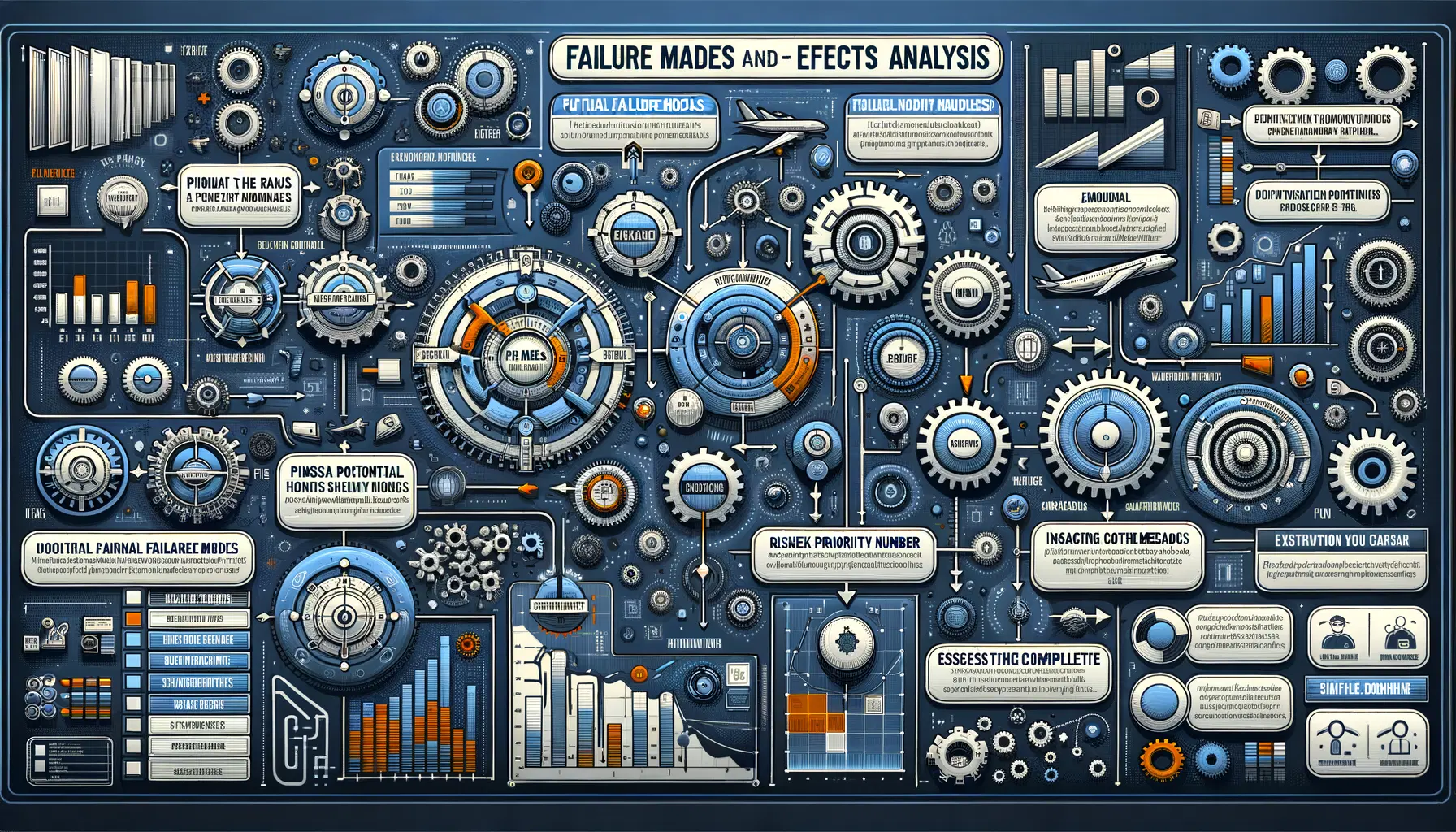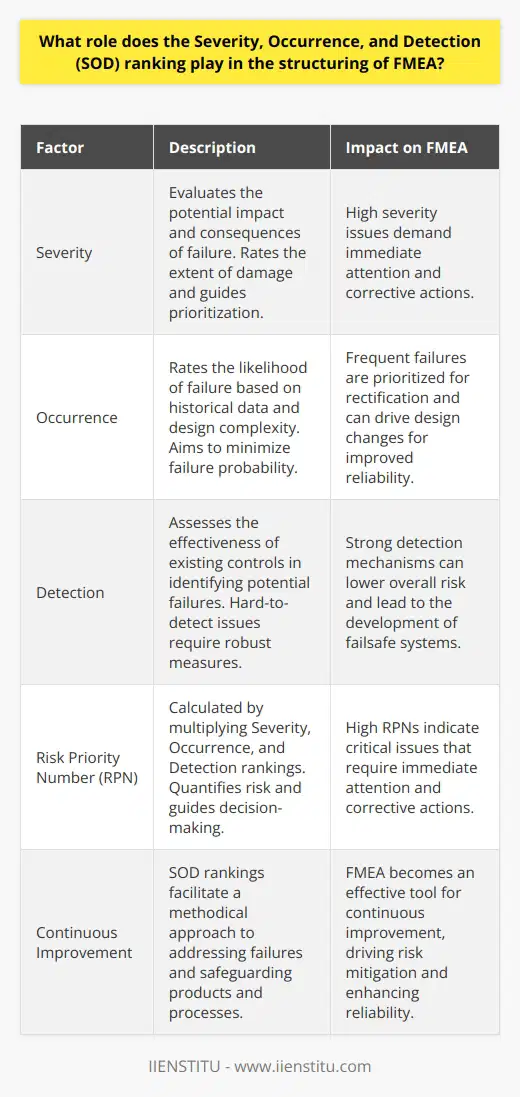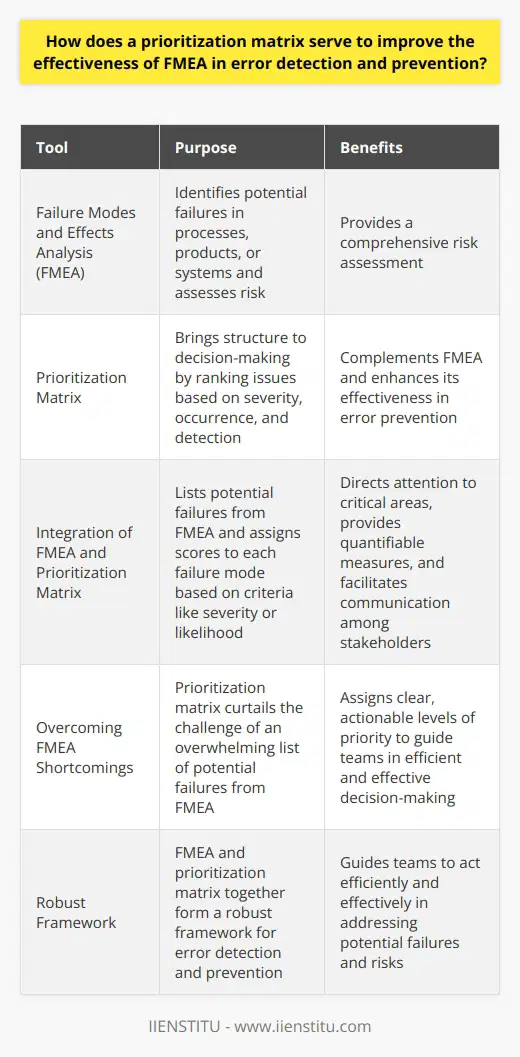
Failure Modes and Effects Analysis (FMEA) is a systematic, proactive method for evaluating a process to identify where and how it might fail and to assess the relative impact of different failures, in order to identify the parts of the process that are most in need of change. FMEA analyzes potential failures using three criteria: occurrence, severity, and detectability.
The practice originated in the 1940s, developed by the U.S. military, and has since evolved into a crucial tool in various industries, including automotive, aerospace, and healthcare, promoting safety and reliability in products and processes. This comprehensive study delves into the nuances and applications of FMEA, shedding light on its significance and providing the reader with a sound understanding of its multifaceted nature.
The importance of FMEA cannot be overstated—it offers organizations a detailed and systematic approach to identify and mitigate risks before they lead to incidents. This preemptive problem-solving tool not only saves costs related to fixing issues post-production but also enhances the safety and quality of the output, which, in turn, builds customer trust and loyalty. Furthermore, the insights gleaned from FMEA can be pivotal in refining production processes and product designs, ensuring improved performance and competitiveness in the market.
Understanding Failure Modes and Effects Analysis (FMEA)
Definition of FMEA
Failure Modes and Effects Analysis (FMEA) is an analytical methodology used to ensure the identification of potential failure modes for a product or process, to assess the risk associated with those failure modes, to rank the issues in terms of importance, and to identify and carry out corrective actions to address the most serious concerns. FMEA serves as a blueprint for risk reduction and is fundamental in the field of quality engineering and risk management.
Purpose of FMEA in various fields
In different sectors, from manufacturing to services, FMEA serves a pivotal role in risk management and quality improvement. For manufacturing, it helps in scrutinizing product design or production processes for potential weaknesses. In the healthcare field, it's used to improve patient safety by identifying possible points of failure in healthcare delivery. The aerospace and automotive industries use FMEA to meet rigorous safety standards and regulations, preventing failures that could be catastrophic due to the high risk associated with their products and services.
Historical development of FMEA
The genesis of FMEA traces back to the 1940s when the U.S. military introduced the procedure to mitigate risks in the defense systems. The methodology was further refined and adopted by the aerospace industry in the 1960s, especially during the Apollo missions to ensure the reliability of spacecraft. Over time, the automotive industry, particularly Ford Motor Company in the 1970s, followed suit, integrating FMEA into their quality assurance practices. Today, FMEA is a cornerstone of industry-wide risk management strategies, continually evolving with the complexity of modern engineering and business practices.
The Process of FMEA
Identification of potential failures (failure modes)
The first step in FMEA involves the identification of potential failures, also known as failure modes. Failure modes are the ways in which a process, design, or product can fail to meet the desired performance criteria. These could range from minor inconveniences to catastrophic failures that cause harm or even loss of life. Identifying failure modes requires a deep understanding of the system or product being analyzed and often involves brainstorming sessions with a multidisciplinary team.
Analysis of effects and consequences
Once the potential failure modes are established, the next phase of FMEA is to examine the effects and consequences of these failures. This analysis is crucial to understand the impact of the failures on the system, user safety, and overall product or process performance. This step determines the severity of each failure mode and can often lead to insights into the interconnectedness of system components and how they may contribute to unintended outcomes.
Risk assessment
The culmination of identifying and analyzing failure modes leads to risk assessment. This is usually quantified by the Risk Priority Number (RPN), which is a product of three factors: severity, occurrence, and detectability. The RPN helps in prioritizing which failure modes require immediate attention and resources to mitigate risks. A robust understanding and application of risk assessment within FMEA allow organizations to allocate their efforts effectively and prevent failures efficiently.
Types of FMEA
Design FMEA
Design FMEA (DFMEA) focuses on potential failures related to product design before they are put into production. It helps designers forecast and eliminate flaws during the earliest stages of product development. Design FMEA ensures product reliability and safety, preventing costly recalls and brand damage. Examples of design FMEA can be found in the automotive industry where DFMEA is fundamental in vehicle systems, from brakes to electronic components, to ensure that the design is robust against possible failure modes.
Process FMEA
Process FMEA (PFMEA), on the other hand, is used to analyze manufacturing and assembly processes. It aims to eliminate risks associated with the production of goods by identifying potential failures that could arise from the malfunction of machinery, human error, material issues, or ineffective control measures. By examining these potential sources of failure, organizations can modify their processes to increase efficiency and reduce the likelihood of product defects. For instance, in semiconductor manufacturing, PFMEA could be applied to reduce the risk of defects in the wafer production process.
Steps in Conducting FMEA
Assembling the team, reviewing the process or design, identifying potential failure modes, evaluating the effects and risks, developing action plans, and implementing and reviewing the effectiveness of the plans constitute the systematic steps to conduct an effective FMEA. Each of these steps requires meticulous attention and coordination among the team members, often calling upon the expertise of engineers, technicians, and managers.
The team's composition is as important as the subsequent steps since the collective experience and knowledge influence the outcome of the FMEA. Reviewing the process or design in question is performed with the intent to understand every single element and interaction within the system. This stage sets the groundwork for the subsequent identification of potential failure modes.
Evaluating the effects and risks allows the team to prioritize issues based on severity and likelihood. It is a stage that demands critical thinking and objective assessment. Developing action plans involves strategizing how to address, mitigate, or eliminate the identified risks, while implementation and review ensure that the strategies are put into practice and are effective in enhancing the reliability and safety of the product or process.
Benefits and Limitations of FMEA
Advantages of using FMEA
Among the advantages, FMEA provides a structured approach for organizations to preemptively prevent malfunctions. It has the potential to significantly reduce the incidence of product recalls and defects, which protects the consumer and fortifies the company's reputation. This preventive action saves costs associated with post-market fixes and contributes to customer satisfaction and loyalty. Moreover, FMEA facilitates regulatory compliance in industries where safety is critically regulated, providing documented evidence of due diligence in risk management.
Limitations of FMEA
However, FMEA comes with its limitations. The process can be complex, requiring significant time and resource investments. The effectiveness of an FMEA is highly dependent on the experience and the analytical capability of the team conducting it. If the team lacks the necessary expertise or if they do not have a comprehensive understanding of the product or process, there is a risk of overlooking significant failure modes or misjudging their impact.
Case Studies and Examples of FMEA Application
FMEA in the automotive sector
In the automotive sector, FMEA has become an integral part of the design and manufacturing process. For instance, when a new vehicle model is being developed, design FMEA is implemented to address any possible issue that can lead to safety hazards or malfunctions before the model is mass-produced. This proactive measure can prevent massive recall campaigns that incur significant costs and affect the brand's reputation.
FMEA in the healthcare industry
In healthcare, FMEA has been used to improve patient safety. A well-documented case is the use of FMEA in reducing medication errors in hospitals. By analyzing the medication administration process, potential errors were identified and changes were implemented, such as standardizing the medication labeling and enhancing the electronic medical record system, which led to a substantial decrease in prescription and administration errors.
FMEA in manufacturing
Similarly, FMEA exercises in the manufacturing sector have led to significant improvements in product quality and process efficiency. An electronics manufacturer, for instance, applied process FMEA to their circuit board assembly line and identified a high risk of component failure due to electrostatic discharge. The subsequent action reduced component failure rates, enhanced product reliability, and resulted in cost savings by minimizing waste and rework.
Conclusion
Throughout this comprehensive study, the multifaceted approach of Failure Modes and Effects Analysis (FMEA) has been discussed, highlighting its critical role in predicting and preventing potential failures across various industries. The future trends and developments of FMEA are leaning towards integration with other risk assessment tools and the utilization of advanced data analytics for even finer precision in identifying and mitigating risks.
Our reflections on the effectiveness and importance of FMEA stand firm—it remains an invaluable tool in promoting the reliability and safety of products and processes while serving as an essential part of risk management and regulatory compliance. As we continue to confront complex technical challenges in product design and process development, FMEA provides a structured and robust methodology to guide us toward innovative solutions and continual improvement.
Frequently Asked Questions
What role does the Severity, Occurrence, and Detection (SOD) ranking play in the structuring of FMEA?
Understanding SOD in FMEA
The Failure Mode and Effects Analysis (FMEA) stands crucial in managing and mitigating risks. It serves as a systematic approach. Quality engineers extensively adopt it. They seek to avoid systemic failures. Here, the SOD ranking emerges as integral.
The Core of SOD
Severity, Occurrence, and Detection formulate this core ranking. Each factor holds significant weight. They are not standalone elements. Rather, they intertwine within the FMEA structure.
Depth into Severity
Severity evaluates the potential impact. It is linked to the consequences of failure. The extent of damage guides the rating. Engineers must visualize the worst-case scenario. High severity demands immediate attention.
Occurrence's Role
Occurrence rates the likelihood of failure happening. It factors in historical data and design complexity. Frequent failures push for prioritized rectification. The aim is to minimize the probability. It can drive design changes for reliability.
The Detection Dimension
Detection looks at the identification of potential failures. It assesses the existing control's effectiveness. Hard-to-detect issues require robust measures. Strong detection mechanisms can lower overall risk. This leads to the development of more failsafe systems.
The Structuring Power of SOD
In the structuring of FMEA, the SOD ranking reigns supreme.
Hierarchizing Risks
SOD rankings help hierarchize risks. They create an order for addressing issues. High severity takes the forefront. Frequent failures follow. Poor detection capability also gets prioritized. This hierarchy streamlines the mitigation process.
Driving Corrective Actions
The SOD ranking drives corrective measures. It informs what to fix first. High scores warrant urgent action. This system ensures efficient resource allocation. It strategically targets the manufacturing process.
Quantifying Risk
The SOD rankings assist in quantifying risk. They transform subjective assessments into objective numbers. Each ranking correlates to a specific value. Combined, they produce a Risk Priority Number (RPN). The RPN guides decision-making.
Facilitating Communication
The SOD rankings foster clear communication. They provide a universal language for risk. Teams across functions can understand priorities. This shared understanding is vital. It encourages collaboration.
Conclusion
The SOD ranking in FMEA is not a mere adjunct. It serves as the backbone of risk evaluation. Each element—severity, occurrence, and detection—plays a pivotal role. Together, they provide a robust framework for addressing failures. They offer a methodical means to safeguard products and processes. Through the SOD ranking, FMEA becomes an effective tool for continuous improvement.

How does a prioritization matrix serve to improve the effectiveness of FMEA in error detection and prevention?
Prioritization in FMEA
Background: The Role of FMEA
Failure Modes and Effects Analysis (FMEA) stands out among error detection tools. It identifies potential failures in processes, products, or systems. Teams use FMEA to assess risk, prioritizing which issue to address first. However, FMEA falls short if it does not properly prioritize risks.
Enhancing FMEA with a Prioritization Matrix
A prioritization matrix comes in as a vital counterpart. It brings structure to decision-making. This tool helps in ranking issues based on severity, occurrence, and detection. By doing so, it complements FMEA's comprehensive risk assessment.
The Process of Integrating a Prioritization Matrix
One must first list all potential failures from FMEA. Then, assess each failure mode using criteria like severity or likelihood. The matrix requires each mode to have a score. Higher scores signal higher priority. Effectiveness in error prevention increases.
Clear Benefits
Streamlines Focus
The matrix directs attention to critical areas. Teams target the highest risks, improving resource allocation. They do not waste time on low-priority issues.
Provides Quantifiable Measures
It offers objective comparison points. Teams can quantify the impact of different failures. This objectivity reduces biases in decision-making.
Facilitates Communication
Stakeholders can easily understand priority levels. The visual nature of the matrix conveys complex data simply. It ensures everyone aligns on the focal points.
Overcoming FMEA Shortcomings
FMEA alone may yield an overwhelming list of potential failures. Teams might find it challenging to discern where to start. The prioritization matrix curtails this challenge. It assigns clear, actionable levels of priority.
Conclusion
A prioritization matrix does not replace FMEA. It enhances it. Together, they form a robust framework for error detection and prevention. They guide teams to act efficiently and effectively.

Can you explain the relationship between FMEA and risk prioritization in the management of product design and process improvement?
Understanding FMEA in Product Design and Process Improvement
FMEA, or Failure Mode and Effects Analysis, is a structured approach. It guides teams to identify potential failure modes. These modes are within a product design or a process. The analysis aims to determine the effects of these failures on system performance. It helps prioritize the risks. This ensures quality and reliability in the final output.
The Core of Risk Prioritization
Risk prioritization is integral to risk management. It decides where the focus should lie. The goal is to mitigate significant risks. Those that affect safety, quality, and functionality get top priority. Lesser risks may receive lower priority.
Interplay between FMEA and Risk Prioritization
FMEA acts as a tool. It specifically feeds into risk prioritization. The methodology conveys clear benefits. It highlights what needs immediate attention. This helps in optimizing resources. It also streamlines the efficiency of risk management practices.
- Identify Failure Modes
- Gauge Severity
- Assess Occurrence Likelihood
- Evaluate Detection Capability
These steps are essential. They pinpoint the risk associated with each failure mode.
Severity, Occurrence, and Detection: The Triad of FMEA
Severity, occurrence, and detection form a triad in FMEA. Each factor receives a score. A higher score typically indicates a higher risk.
- Severity: Impact of the failure on the system
- Occurrence: Probability of the failure happening
- Detection: Likelihood of the failure being detected before it occurs
Combining these scores gives a Risk Priority Number (RPN). The RPN guides decision-makers. High RPNs signal high-priority issues.
Conclusion
FMEA is systematic and thorough. It lays the foundation for effective risk prioritization. Through FMEA, teams can confidently assess risks. They then prioritize actions that maximize product quality and process reliability. This synergy ensures the management of product design and process improvement is data-driven. It also aligns with strategic objectives. Consequently, organizations can better anticipate challenges. They maintain a competitive edge in their respective markets.



